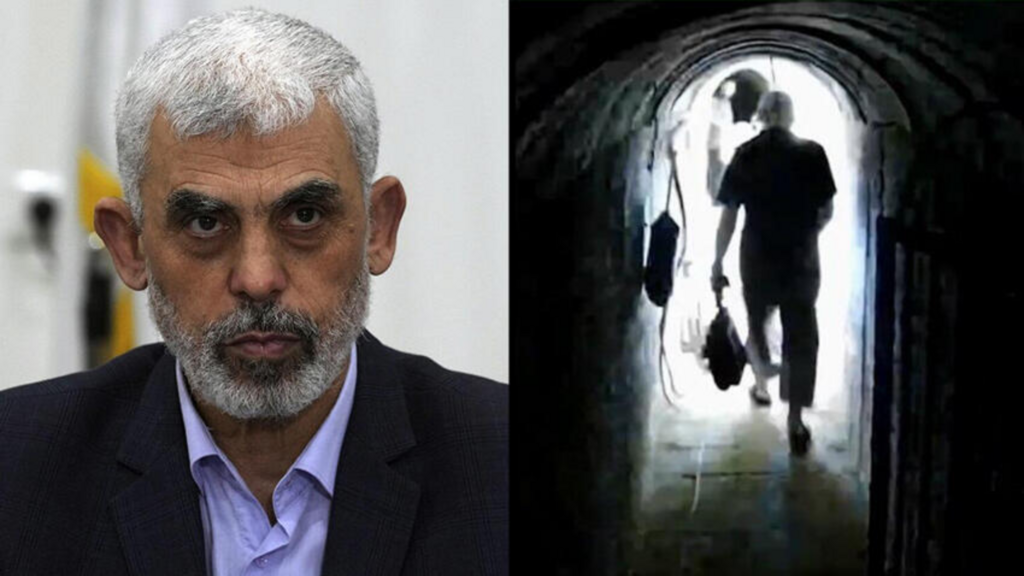A week after the appointment of Hamas leader in Gaza, Yahya Sinwar, as the head of the political bureau of the terrorist organization, replacing Ismail Haniyeh, who was eliminated in Tehran, the London-based Arabic newspaper Asharq Al-Awsat is shedding some light on how he operates and sends messages to the Hamas leadership and negotiators.
According to sources who spoke to the newspaper, only people he trusts know his current location. Sinwar moves from place to place, and these trusted individuals serve as a link between him and the rest of the leadership when necessary.
A senior source revealed that, after creating a "secure environment" for himself, Sinwar manages to conduct phone conversations. The source stated that this "took a long time" and that this small circle he created around him "works to secure everything he needs and to ensure his communication with the movement's leaders inside and outside, through complex methods."
The source said that Sinwar "handled various situations, giving instructions once every two weeks and sometimes once a month to senior movement officials." He added that the information was delivered in handwriting, sometimes printed, and bore his signature, but no one knew how it was transferred. Sources claim that he relies on manual transfer in complete secrecy from one person to another.
With his surprise "promotion," the question arises as to how he will fulfill all the movement's commitments, including message transmission and discussions regarding hostage deals.
His brother, Mohammed Sinwar, a senior commander in the Al-Qassam Brigades, is apparently leading it in place of Mohammed Deif, who was assassinated last month. According to Asharq Al-Awsat, this brother is the one overseeing Yahya's hiding places and movements. Mohammed Sinwar, it should be noted, is one of Israel's most wanted, as he is one of the architects of the October 7 massacre, and he has a special connection with his brother. Some believe he is even more militant and rigid.
According to one of the sources who spoke to the newspaper, Yahya Sinwar, who has made no public appearances, is not disconnected from the movement. He claims Sinwar is in regular contact with everyone, in various ways. Another source said that it is important for Sinwar to send internal and external messages from time to time related to the nature of the work and how to deal with the difficulties and obstacles imposed by the war on the reality of political, military and even internal work within Gaza.
2 View gallery


Mohammed Sinwar, an architect of the October 7 massacre
(Photo: IDF Spokesperson's Unit)
Since the beginning of the war, Hamas has adopted a method of manual messaging. In other words, they do not talk on phones or use cellular networks but rather old methods of writing messages on paper and sending them to various senior officials through messengers working within the movement.
On Monday, the Saudi television network Al-Arabiya reported that the message carrier for the Rafah Brigade commander, Mohammed Shabana, is the person who allegedly revealed the location of the head of the military wing of the terrorist organization, Mohammed Deif – thereby enabling Israel to eliminate him in an airstrike about a month ago, an attack in which his right-hand man and Khan Younis Brigade commander, Rafah Salama, were also killed.
Sources quoted in the Saudi report said that in the investigation conducted by Hamas after the assassination in Khan Younis on July 13, it was revealed that the "informant" who disclosed his location was the same messenger who, according to the report, is a member of Hamas' military wing. The messenger, it is claimed, was involved in transferring messages from Rafah Brigade commander Mohammed Shabana – who has not yet been eliminated – to various Hamas members. It is claimed that Deif was killed immediately after informing the agent who operated on him about the arch-terrorist's location.
According to the anonymous sources quoted in the report, the informant is a member of a large family from Rafah. It is also alleged that he provided Israel with information about the city's brigade commander, Shabana, and that he handed over detailed maps of Rafah and the tunnels and weapons held there. It is not entirely clear from the report what happened to the "messenger," but it is mentioned that he is still "undergoing investigations."




